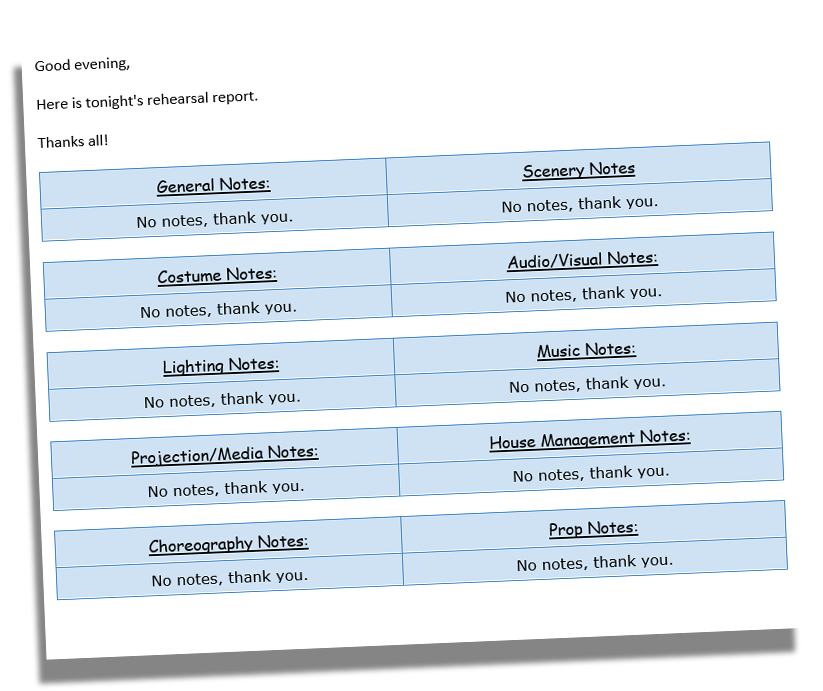Download Rehearsal Report Form
Using this form:
- Tailor the form for your production
If a given area is not used in your production, do not include it in the report. “Choreography” will usually only be used for musicals. You can add areas as they are needed, for example: “puppets” could be included on some shows, or “aerial silks,” or “lion handlers.” - Diplomacy is important
When someone is having a bad day, they are more likely to interpret brief or ambiguous sentences as being abrupt. There is usually no need to be over-the-top with niceties, but steady usage of “please” and “thank you” and the occasional extra compliment go a long way. The mood of the rehearsal reports has a great impact on how everyone perceives the progress of the show. Upbeat & cheerful is a great mood to maintain. - “No Notes” is a good note.
If there are no notes for a given area, say so in the report. Everyone in the company should be in the habit of checking the rehearsal report each evening or morning after it comes out. If instead of “No notes” a category is simply blank, there is a possibility that the lack of notes is unintentional. - State the problem, not the solution. Maybe suggest a possible fix. 😉
When copying the notes taken during rehearsal, expand your thoughts a little when creating these reports. “Put handles on barrels” is super-brief, possibly even rude. It does not provide much information about the problem, and it might cause friction with specific esthetic or practical considerations among scenery and props that are not yet on the radar of the director or the performers. Consider instead: “The barrels are difficult to move with the staging. Wooden or rope handles might be a solution. Scenery and props: please discuss options with the director.” - Emailing the Report
When you email this form out, copy and paste it into the body of the email. Most email clients will support this perfectly well, and it guarantees that everyone can see the report quickly and easily without having to open an attachment. Share the reports with everyone involved with the listed areas, all creative staff, and the leaders of all technical areas. Rehearsal Reports are not typically sent to performers. - Be Consistent & Clean
If the reports always have the same format, fonts, colors, etc., they are easy to notice and easy to read. Comic Sans is in use here – and many people abhor it. It is casual and friendly, but feel free to change it to something that suits your style. The same is true with the background colors of those little tables. Avoid making your form too busy with multiple colors. A riot of color and forms creates visual noise. Let the information in the form be clear and easy to read. Do not make it compete for attention with the layout or the composition. Keep it simple. - Delete this page, of course, before distributing the form. 😊
